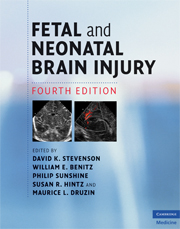Book contents
- Frontmatter
- Contents
- List of contributors
- Foreword
- Preface
- Section 1 Epidemiology, pathophysiology, and pathogenesis of fetal and neonatal brain injury
- Section 2 Pregnancy, labor, and delivery complications causing brain injury
- Section 3 Diagnosis of the infant with brain injury
- Section 4 Specific conditions associated with fetal and neonatal brain injury
- 22 Congenital malformations of the brain
- 23 Neurogenetic disorders of the brain
- 24 Hemorrhagic lesions of the central nervous system
- 25 Neonatal stroke
- 26 Hypoglycemia in the neonate
- 27 Hyperbilirubinemia and kernicterus
- 28 Polycythemia and fetal–maternal bleeding
- 29 Hydrops fetalis
- 30 Bacterial sepsis in the neonate
- 31 Neonatal bacterial meningitis
- 32 Neurological sequelae of congenital perinatal infection
- 33 Perinatal human immunodeficiency virus infection
- 34 Inborn errors of metabolism with features of hypoxic–ischemic encephalopathy
- 35 Acidosis and alkalosis
- 36 Meconium staining and the meconium aspiration syndrome
- 37 Persistent pulmonary hypertension of the newborn
- 38 Pediatric cardiac surgery: relevance to fetal and neonatal brain injury
- Section 5 Management of the depressed or neurologically dysfunctional neonate
- Section 6 Assessing outcome of the brain-injured infant
- Index
- Plate section
- References
30 - Bacterial sepsis in the neonate
from Section 4 - Specific conditions associated with fetal and neonatal brain injury
Published online by Cambridge University Press: 12 January 2010
- Frontmatter
- Contents
- List of contributors
- Foreword
- Preface
- Section 1 Epidemiology, pathophysiology, and pathogenesis of fetal and neonatal brain injury
- Section 2 Pregnancy, labor, and delivery complications causing brain injury
- Section 3 Diagnosis of the infant with brain injury
- Section 4 Specific conditions associated with fetal and neonatal brain injury
- 22 Congenital malformations of the brain
- 23 Neurogenetic disorders of the brain
- 24 Hemorrhagic lesions of the central nervous system
- 25 Neonatal stroke
- 26 Hypoglycemia in the neonate
- 27 Hyperbilirubinemia and kernicterus
- 28 Polycythemia and fetal–maternal bleeding
- 29 Hydrops fetalis
- 30 Bacterial sepsis in the neonate
- 31 Neonatal bacterial meningitis
- 32 Neurological sequelae of congenital perinatal infection
- 33 Perinatal human immunodeficiency virus infection
- 34 Inborn errors of metabolism with features of hypoxic–ischemic encephalopathy
- 35 Acidosis and alkalosis
- 36 Meconium staining and the meconium aspiration syndrome
- 37 Persistent pulmonary hypertension of the newborn
- 38 Pediatric cardiac surgery: relevance to fetal and neonatal brain injury
- Section 5 Management of the depressed or neurologically dysfunctional neonate
- Section 6 Assessing outcome of the brain-injured infant
- Index
- Plate section
- References
Summary
Introduction
Bacterial sepsis in the neonate is a significant cause of morbidity and mortality. More than half of all admissions to a neonatal intensive care unit (NICU) are for infants with or who are at risk of developing sepsis. Diagnosis is challenging since clinical signs are non-specific, supportive rapid screening laboratory assays lack good positive predictive value (PPV), and the entity carries a high mortality rate. As a result, a conservative approach to these patients has evolved, with many infants who are not septic receiving antibiotics. This chapter will discuss the epidemiology, diagnosis, treatment, and prevention of neonatal sepsis.
Meningitis accompanies sepsis in approximately one-quarter of cases of neonatal disease, and thus the two processes share a common etiology and pathogenesis. This chapter will cover only bacterial sepsis of the term infant, since meningitis is covered elsewhere (Chapter 31). Further, prematurity and residence in an intensive care unit are independent risk factors for bacterial sepsis that differ from sepsis in the term infant, and these will not be considered here. In addition, the emphasis of this chapter will be on early-onset neonatal disease, with less of a concentration on late-onset sepsis.
- Type
- Chapter
- Information
- Fetal and Neonatal Brain Injury , pp. 331 - 346Publisher: Cambridge University PressPrint publication year: 2009



